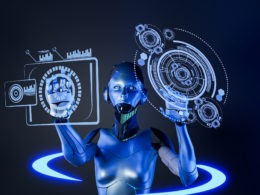Artificial intelligence (AI) has become ubiquitous across industries, and retail is no exception. Following ChatGPT’s launch, AI-driven transformations in retail have accelerated. Retailers are leveraging AI to optimize everything from inventory to customer interactions.
Defining Artificial Intelligence
AI refers to machine-based systems that can perform tasks normally requiring human cognition. This includes interpreting complex information, identifying patterns, and applying learnings to new situations.
A common retail AI application is machine learning, which involves training algorithms to make data-based predictions. As AI capabilities like natural language processing advance, AI retail solutions will continue expanding dramatically.
The AI Retail Push
E-commerce pioneers like Amazon and brick-and-mortar leaders like Target and Walmart have already integrated AI across retail operations. With AI promising enhanced efficiency and customer insights, retail AI investment continues to rise each year.
Specifically, retailers are keenly eying AI’s potential for superior cost management and understanding nuances of customer behavior in new ways. Let’s explore five critical retail areas already experiencing significant AI transformation.
Inventory Forecasting
Accurately predicting consumer demand is invaluable for effectively managing complex global retail supply chains and optimizing inventory. As a result, many leading retailers are turning to increasingly sophisticated AI-powered demand forecasting solutions.
For example, Nike acquired AI retail analytics firm Celect for $110 million in 2019. By processing and analyzing real-time data streams around customer trends and preferences, Celect helps Nike forecast demand in specific regions more precisely. This allows Nike to dynamically stock more of its best-selling items before they sell out while avoiding overstocking less popular products. Key inputs fuelling AI-based demand forecasts include:
- search trends analysis;
- weather pattern mapping;
- historical sales data;
- marketing campaign performance;
- competitor benchmarking;
- economic indicators;
- consumer sentiment metrics.
As the machine learning algorithms ingesting these datasets become more advanced, demand prediction will likely become essential for retail success.
Checkout-Free Retail Technologies
Brick-and-mortar retailers like Amazon are also pioneering the development of AI-powered checkout-free retail technologies, enabling stores where customers can conveniently grab products and walk out without stopping to pay.
Overhead cameras powered by sensor fusion AI detect which products customers select, while computer vision algorithms identify when a customer exits the store. Upon leaving, the customer is automatically billed for the items via a smartphone app. This frictionless brick-and-mortar experience increases convenience for customers, especially those making quick purchases.
While Amazon has faced some notable setbacks scaling its checkout-free “Just Walk Out” technology beyond small-format convenience stores, it continues expanding the system across its Amazon Fresh grocery stores and licensing the platforms to other retail chains. Checkout-free retail capabilities highlight the potentially transformative nature of AI in enhancing and redefining physical retail experiences.
Automated Inventory Monitoring
Monitoring out-of-stock inventory levels and excess inventory has long plagued traditional retail operations. Brick-and-mortar retailers like Walmart have turned to AI-powered analysis of images captured across their thousands of stores to combat inventory issues.
Specifically, Walmart utilizes cameras attached to floor-cleaning scrubber machines, which record shelf inventory levels as they traverse store aisles overnight. In aggregate, these smart scrubbers capture over 20 million images of merchandise store shelves daily. Powerful AI image analysis algorithms then process this imagery dataset to determine which specific brands and products appear to be out of stock on given shelves.
This enables Walmart store managers to identify low inventory SKUs each morning quickly and rapidly restock selling items. Overall inventory is kept at optimum levels while limiting lost sales opportunities.
As additional capabilities like automated on-shelf product level monitoring through digital shelf labels, edge computing, and retail drone analysis mature, retail floors will likely reflect even more dynamic and optimized layouts and stock levels.
Customer Sentiment Tracking
Carefully monitoring and analyzing brand perception and satisfaction across the customer base is growing increasingly critical for retailers to retain loyal patrons. As a result, many top retailers utilize natural language processing algorithms capable of automatically assessing both structured and unstructured consumer feedback data across channels.
By ingesting vast datasets of customer support conversations, product reviews, forum discussions and social media engagement, advanced sentiment analysis algorithms can extract and categorize the most salient complaint topics and emerging issues. Simultaneously, they can gauge overall engagement levels and brand favorability over time.
Retailers may take focused action by resolving persistent customer concerns with the help of AI-powered capabilities, before they become PR catastrophes that go viral on social media. Retailers may further refine upcoming efforts and analyze integrated marketing campaign performance holistically by utilizing consumer sentiment analytics.
Retailers may be able to use interactive sentiment polling techniques to directly engage customers at scale when conversational AI helpers like ChatGPT develop. Retailers and customers may have never-before-seen ties thanks to this, but brands will also need to uphold a high standard of honesty.
Voice of Customer Analysis
Closely related to general customer sentiment tracking, the voice of the customer analysis focuses specifically on extracting actionable insights directly from customer feedback. This typically combines sentiment analysis, text analytics, and natural language processing to produce summaries of pain points and product opportunities useful for guiding development.
For example, software company Productboard ingests inputs like NPS surveys, support tickets, app store reviews, sales conversations, and win/loss reports across the entire customer lifecycle journey. Leveraging AI, it then surfaces the most requested features or frustrating user experiences as ranked by customer frequency.
Conversational AI Assistants
While much of the current retail AI focus lies behind the scenes in optimizing planning and operations, innovations utilizing consumer-facing conversational AI tools are rising. Specifically, retailers are beginning to adopt chatbots leveraging natural language processing to engage customers through messengers, apps, websites, and voice assistants.
Key capabilities provided by conversational retail chatbots include:
- inventory availability checking;
- product specifications lookups;
- order status updates;
- returns and exchange initiation;
- personalized promotions and discounts;
- payment confirmation details.
Powered by deep learning and neural networks, advanced NLP algorithms analyze context and sentiment to understand nuanced customer queries. In turn, they can serve up relevant product details, inventory lookups, promotions alerts, order status checks, and more. If queries fall outside the chatbot’s scope, the conversation seamlessly escalates to human agents.
Conversational interfaces allow customers to get quick answers to questions without calling overwhelmed support centers. They also provide retailers with valuable user data to improve experiences. Over time, capabilities like personalized recommendations may even be integrated.
Through continuing innovation, forward-thinking retailers will unlock game-changing applications of conversational AI. Those ignoring this front may lose opportunities to engage digitally-native consumers.
The Future with Retail AI
While current retail AI focus lies primarily on back-end efficiencies around forecasting, supply chain analytics, and inventory, all indicators point to rapidly emerging customer-impacting AI innovations. Conversational AI for heightened digital engagement has already seen early traction.
But applications perhaps on the horizon could be even more transformative – what if shoppers in augmented reality stores see personalized product recommendations, pricing offers, and discounts tailored specifically to their profile through retinal displays? AI may power this future.
In the years ahead, retailers embracing sophisticated data-driven business strategies will be best positioned to lead the next waves of retail AI innovation. They stand to unlock immense value for customers through superior experiences and for companies themselves through optimized operations. Artificial intelligence will undoubtedly shape the future of retail.
Conclusion
AI is already showing off its enormous potential to revolutionize retail in terms of consumer and planning channels. The potential uses to improve revenue growth and customer happiness are still far beyond our current understanding. Businesses which embrace AI’s present benefits and make early investments in its advancement will be able to compete at the top of their respective industries for many years to come.
“Are you ready to embrace emerging tools to drive the next level of competitive differentiation?” is the crucial question facing all retail CEOs. Or are you going to let disruptors powered by technology overtake you? In ten years, artificial intelligence will surely have drastically changed the retail scene.












